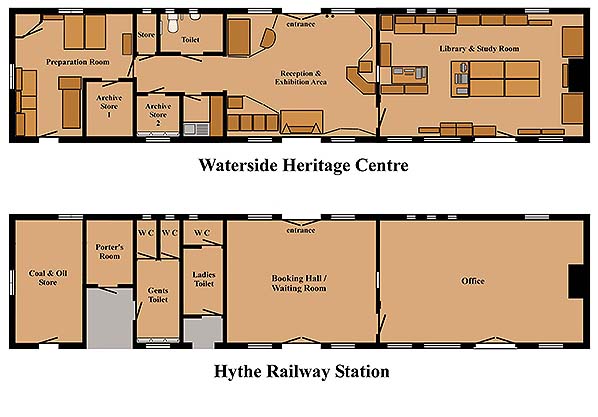
[Source: Nick Catford] Hythe Station Gallery 4: December 1975 - December 2014 4.jpg) Hythe station, forecourt side, looking towards Fawley in December 1975. As with other station buildings on the branch, that at Hythe was utilitarian, resembling a public lavatory. Beyond the gate, left background, had once been a dock at the rear of the platform. Hythe goods yard was something of an oddity, being at a lower level and out of view to the left. The photographer is standing on the station approach road which, behind the camera, swung round northwards to join Shore Road.
Photo by Nick Catford 7.jpg)
Hythe station looking east in in May 1978. Much of the undergrowth surrounding the building has been cleared from the end wall. The window appears to be boarded up on the inside.
Photo
by Alan Young
26.jpg)
'Fawley Flyer' On 23 April 1978 one of the British Young Travellers’ Society 'Fawley Flyer' shuttles approaches Hythe on its way to Fawley. 'Hampshire' Class 205 DEMU No.1128 leads the train. The other unit was No.1131. With the introduction of TOPS a few years earlier SR units, diesel or electric, received their class numbers but the Southern Region was slow to apply these visually to the units and the practice did not really become widespread until the advent of so-called 'privatisation'. Unfortunately 'privatisation' brought some of the vilest liveries ever seen on Britain's trains. Unit 1128 was to end up with Connex with its dreadful livery resembling a departmental weed-killing train and as unit 205028 it was, like many others, to have this number repeated on both sides of the cab front. This may have been acceptable on gangwayed EMUs but looked ridiculous on these flat-fronted DEMUs; BR's unit number placed centrally as seen here was far neater. No.1128 was to survive in service until November 2004 and is now preserved. On the left is an everyday scene then and now: washing hanging out to dry. In the days of steam, for anybody living close to a railway smuts were always a problem and, despite Monday being the traditional washing day, the more astute housewife might vary the day according to wind direction. Similar problems existed when people lived in industrial areas but by and large people simply 'got on with it' and accepted their lot.
Photo by Ian Nolan from his Flickr photostream 27.jpg)
Class 205 DEMU No.1131 at the rear of one of the 'Fawley Flyer' shuttles as it passes
Hythe on 23 April 1978. Photo by Ian Nolan from his Flickr photostream 28.jpg) Hythe station building seen from a passing 'Fawley Flyer' shuttle on 23 April 1978. The forecourt and former dock area looks tidy while the station building is fenced off from the overgrown remains of the platform. Presumably the building was now in private ownership. At far right and on the lower level can be seen part of what was Hythe goods yard. The area formerly occupied by the sidings now appears to be covered in tarmac. Today the goods yard site is covered by housing entered via Dominy Close, the former station approach road, which now turns into the estate before reaching the station forecourt which is gated off and inaccessible to the public. The strip between Dominy Close and the railway is now heavily wooded, while the only evidence of the existence of the goods yard is some walling
on Shore Road. Photo by Ian Nolan from his Flickr photostream 8.jpg)
Hythe station, looking towards Fawley, in August 1980. The platform has been cut back away from the track and what remains has become overgrown. At the same time, it would appear that the track has been re-aligned away from the platform. Note the cable run on the left.
Photo by John Mann 30.jpg)
Hythe station in 1984 looking towards Fawley. By this time the site is difficult to recognise as a former station and young trees are now gaining a foothold on what remained of the platform. The three light fittings once beneath the eaves of the station building seem to have disappeared but the white gate still stands defiantly. The chimney pot on the station building, which once leaned seemingly in different directions according to time of year, has now been dealt with.
Photo by John Law from his Flickr photostream 38.jpg)
Hythe booking office in 1995, shortly before renovation of the building started.
Photo from Waterside Heritage 31.jpg)
Looking north-west at Hythe station in March 2014. The shrubs in front of the station building have grown into trees and the building will probably be difficult to see in summer months. Although looking a little rusty the track still saw regular traffic to Fawley refinery and Marchwood Military Port at this time. This will now be reduced following the ending of crude oil traffic on 1 September 2016.
Photo by Nick Catford 32.jpg) Hythe station forecourt in March 2014. The building has been renovated and now houses the Waterside Heritage Centre which is open Wednesday, Thursday and Saturday morning.
Photo by Nick Catford 35.jpg)
33.jpg)
The public display area for the Waterside Heritage Centre is located in the former waiting room and booking hall of Hythe station, seen here in November 2016. The station entrance was to the left with the door to the platform to the right behind the display. The original ticket window is still in place.
Photo by Nick Catford 34.jpg)
Hythe booking office now houses thge library and study room for the Waterside Heritage Centre seen here in November 2016.
Photo by Nick Catford Click on thumbnail to enlarge
 Home Page Home Page
|


thumb29.jpg)
thumb9.jpg)

thumb37.jpg)
thumb36.jpg)
